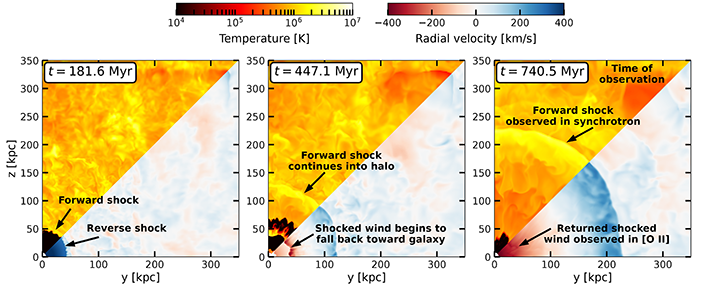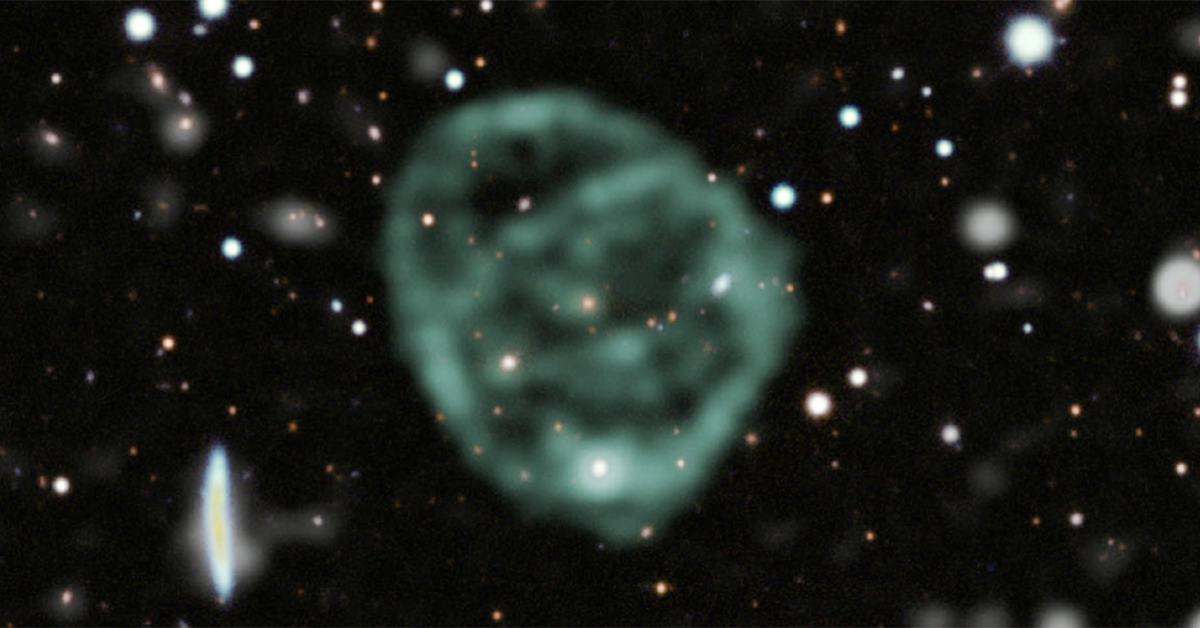Written by Michelle Franklin, APR
Director of Communications, Physical Sciences at University of California, San Diego
Maunakea, Hawai‘i– It’s not every day astronomers say, “What is that?” After all, most observed astronomical phenomena are known: stars, planets, black holes and galaxies. But in 2019 the newly completed ASKAP (Australian Square Kilometer Array Pathfinder) telescope picked up something no one had ever seen before: radio wave circles so large they contained entire galaxies in their centers.
As the astrophysics community tried to determine what these circles were, they also wanted to know why the circles were. Now a team led by University of California San Diego Professor of Astronomy and Astrophysics Alison Coil believes they may have found the answer: the circles are shells formed by outflowing galactic winds, possibly from massive exploding stars known as supernovae. Their work is published in Nature.
Coil and her collaborators have been studying massive “starburst” galaxies that can drive these ultra-fast outflowing winds. Starburst galaxies have an exceptionally high rate of star formation. When stars die and explode, they expel gas from the star and its surroundings back into interstellar space. If enough stars explode near each other at the same time, the force of these explosions can push the gas out of the galaxy itself into outflowing winds, which can travel at up to 2,000 kilometers/second.
“These galaxies are really interesting,” said Coil, who is also chair of the Department of Astronomy and Astrophysics. “They occur when two big galaxies collide. The merger pushes all the gas into a very small region, which causes an intense burst of star formation. Massive stars burn out quickly and when they die, they expel their gas as outflowing winds.”
Technological developments allowed ASKAP to scan large portions of the sky at very faint limits which made odd radio circles (ORCs) detectable for the first time in 2019. The ORCs were enormous — hundreds of kiloparsecs across, where a kiloparsec is equal to 3,260 light years (for reference, the Milky Way galaxy is about 30 kiloparsecs across).
Multiple theories were proposed to explain the origin of ORCs, including planetary nebulae and black hole mergers, but radio data alone could not discriminate between the theories. Coil and her collaborators were intrigued and thought it was possible the radio rings were a development from the later stages of the starburst galaxies they had been studying. They began looking into ORC 4 — the first ORC discovered that is observable from the Northern Hemisphere.
Up until then, ORCs had only been observed through their radio emissions, without any optical data. Coil’s team used an integral field spectrograph at the W. M. Keck Observatory on Maunakea, Hawai‘i, to look at ORC 4, which revealed a tremendous amount of highly luminous, heated, compressed gas — far more than is seen in the average galaxy.

With more questions than answers, the team got down to detective work. Using optical and infrared imaging data, they determined the stars inside ORC 4 galaxy were around 6 billion years old. “There was a burst of star formation in this galaxy, but it ended roughly a billion years ago,” stated Coil.
Cassandra Lochhaas, a postdoctoral fellow at the Harvard & Smithsonian Center for Astrophysics specializing in the theoretical side of galactic winds and a co-author on the paper, ran a suite of numerical computer simulations to replicate the size and properties of the large-scale radio ring, including the large amount of shocked, cool gas in the central galaxy.
Her simulations showed outflowing galactic winds blowing for 200 million years before they shut off. When the wind stopped, a forward-moving shock continued to propel high-temperature gas out of the galaxy and created a radio ring, while a reverse shock sent cooler gas falling back onto the galaxy. The simulation played out over 750 million years — within the ballpark of the estimated one-billion-year stellar age of ORC 4.
“To make this work you need a high-mass outflow rate, meaning it’s ejecting a lot of material very quickly. And the surrounding gas just outside the galaxy has to be low density, otherwise the shock stalls. These are the two key factors,” stated Coil. “It turns out the galaxies we’ve been studying have these high-mass outflow rates. They’re rare, but they do exist. I really do think this points to ORCs originating from some kind of outflowing galactic winds.”
Not only can outflowing winds help astronomers understand ORCs, but ORCs can help astronomers understand outflowing winds as well. “ORCs provide a way for us to ‘see’ the winds through radio data and spectroscopy,” said Coil. “This can help us determine how common these extreme outflowing galactic winds are and what the wind life cycle is. They can also help us learn more about galactic evolution: do all massive galaxies go through an ORC phase? Do spiral galaxies turn elliptical when they are no longer forming stars? I think there is a lot we can learn about ORCs and learn from ORCs.”
ABOUT KCWI
The Keck Cosmic Web Imager (KCWI) is designed to provide visible band, integral field spectroscopy with moderate to high spectral resolution formats and excellent sky-subtraction. The astronomical seeing and large aperture of the telescope enables studies of the connection between galaxies and the gas in their dark matter halos, stellar relics, star clusters, and lensed galaxies. KCWI covers the blue side of the visible spectrum; the instrument also features the Keck Cosmic Reionization Mapper (KCRM), extending KCWI’s coverage to the red side of the visible spectrum. The combination of KCWI-blue and KCRM provides simultaneous high-efficiency spectral coverage across the entire visible spectrum. Support for KCWI was provided by the National Science Foundation, Heising-Simons Foundation, and Mt. Cuba Astronomical Foundation. Support for KCRM was provided by the National Science Foundation and Mt. Cuba Astronomical Foundation.
ABOUT W. M. KECK OBSERVATORY
The W. M. Keck Observatory telescopes are among the most scientifically productive on Earth. The two 10-meter optical/infrared telescopes atop Maunakea on the Island of Hawai‘i feature a suite of advanced instruments including imagers, multi-object spectrographs, high-resolution spectrographs, integral-field spectrometers, and world-leading laser guide star adaptive optics systems. Some of the data presented herein were obtained at Keck Observatory, which is a private 501(c) 3 non-profit organization operated as a scientific partnership among the California Institute of Technology, the University of California, and the National Aeronautics and Space Administration. The Observatory was made possible by the generous financial support of the W. M. Keck Foundation. The authors wish to recognize and acknowledge the very significant cultural role and reverence that the summit of Maunakea has always had within the Native Hawaiian community. We are most fortunate to have the opportunity to conduct observations from this mountain. For more information, visit: www.keckobservatory.org


